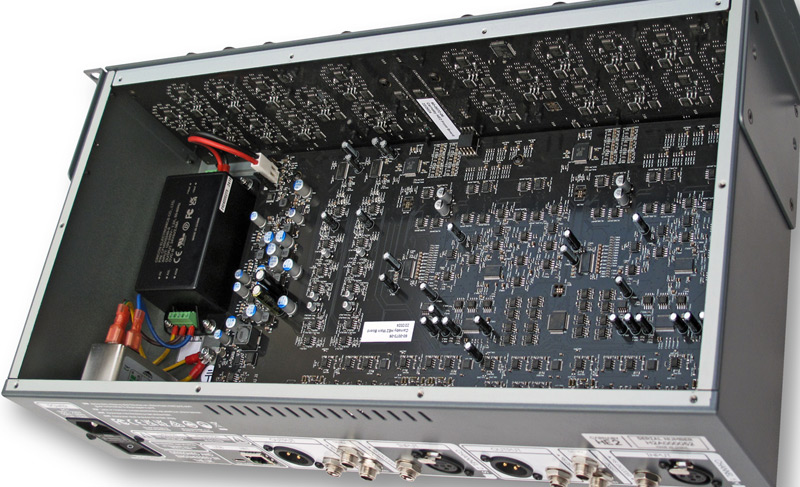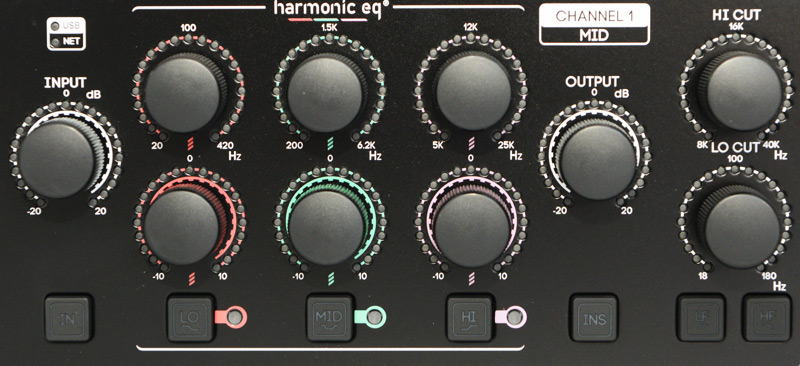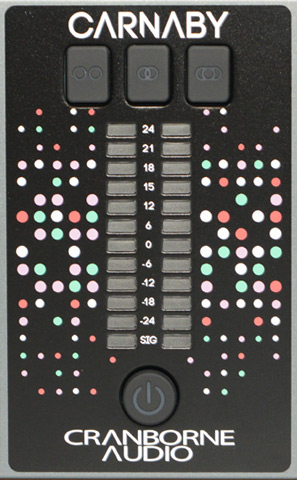Cranborne Audio Carnaby HE2
Two-channel harmonic EQ with plug-in control
Author: Matthias Fuchs | Photos: Peter Kaminski, Matthias Fuchs (3)
The innovative British manufacturer Cranborne Audio caused quite a stir last year with its Carnaby Harmonic Equalizer. The stylish API 500 cassette qualifies as an exciting and unconventional sound-processing device and was able to convince even skeptics effortlessly with its outstanding features.
Carnaby Harmonic EQ has now evolved into a fully-fledged rack device - with two channels and a completely new operating plug-in concept . Reason enough to take a closer look at the Cranborne Audio Carnaby 2HE.
In short, the Carnaby boosts and cuts certain frequency ranges (like a conventional EQ) and enriches them with overtones (the "exciter" or "saturator" nature of the device). Therefore, you could speak somewhat succinctly of an EQ on steroids. Nothing has changed in this highly interesting principle - nor in the circuit technology of the so-called "Saturation Core" and its basic sound characteristics. We would therefore like to take a closer look at the differences in the new HE2. For further information, please refer to the previously published test report on the Carnaby 500 module.
Concept and equipment
In addition to eye-catching new features and a changed form factor, the HE2ˊs operating concept was completely redesigned. The fully equipped front panel with its buttons, encoders, and LED wreaths is now supplemented by a DAW plug-in, which can take complete control of the Carnaby HE2 if required. It can also automate all parameters and save presets. A connection to the computer is made via USB-C or a network connection (not yet fully implemented at the time of testing).
There are also new features on the audio side: the actual three-band EQ/saturator segments are now each preceded by a high-pass and low-pass filter. The two already familiar mono- and stereo operating modes were supplemented by an M/S mode - which is a highly interesting feature and a real gain for the HE2, as we will see. Finally, the device has a stereo insert. It is located between the decoder and encoder of the internal center/side matrix and allows any outboard devices to operate in M/S mode.
The equipment is completed by XLR in/outs, stereo jacks for the insert path, and an internal power supply unit with a switch and an additional on/off button.
Anyone who assumes that the Carnaby HE2 simply contains two boards of the 500 module plus some peripherals is far from the truth: the HE2 has completely redesigned boards with high-quality electronics. According to the manufacturer, the proposed solution enables better audio performance and simpler integration of digital controls. In addition, manufacturing costs are reduced when a single board is used.
Handling
Here, too, we want to focus on the new features of the HE2 and again refer to the test of the Carnaby 500 module. The functions of the three harmonic EQ bands correspond exactly to those of the module. The same applies to the input and output controls and system bypass. Separate bypasses were added to the individual frequency bands. Also new are the previously mentioned high- and low-pass filters, which also have their own bypass. These are shelving filters with a proportional Q factor of between six and 12 dB per octave, depending on the gain setting (maximum -3 dB). The operating frequencies are between 8 and 40 kHz or 18 kHz and 180 Hz. These filters can be used to prepare the program signal before the EQ/saturation stages or to optimize it for processing.
The following three buttons determine the operating mode (dual mono, stereo, M/S). In stereo mode, only the controls on the left-hand side are active. In M/S mode, the left side takes over the center, while the side signal is processed on the right.
The aforementioned insert can also be activated via a button and routes the program signal between the MS-De and encoder via the rear jack sockets to the outside and back again. With the help of the Carnaby HE2, you can now finally operate your favorite outboard in M/S mode.
The features are complemented by a large LED display with a peak hold function and an on/off button. The mains switch on the back can therefore remain on.
All controllers are slightly rasterized, high-quality encoders with coloured LED rings. All buttons have status LEDs. This means that the current operating status is fully visualized when controlling via plug-in. The connection to the computer is currently via USB-C. Network compatibility will be added in the future.
The plug-in

The Carnaby HE2 control plug-in is currently available in VST3 and AU formats; AAX was not yet available for testing, but should be when the test is released. A standalone version is also available.
The pleasantly simple and clearly laid-out plug-in shows all the hardware controls. Different presets can be loaded per channel in dual mono and M/S mode; both channels have their own preset management in these modes. If Auto-Connect is active, the connected Carnaby HE2 is recognized when a DAW project is opened and all parameter settings are loaded. If required, you can switch to the current hardware settings using a single click (Restore Hardware State). All parameter changes can be recorded in the DAW as automation data and played back without any perceptible latency. The LEDs and LED rings of the hardware sensor report the value changes. The brightness of the control elements can be adjusted using the plug-in.
Interview with Sean Karpowicz

We had the opportunity to have an in-depth conversation with Cranborne Audio's Managing Director and co-founder Sean Karpowicz, which we would like to summarize here.
According to Sean Karpowicz, the development of the Camden preamp and its transformer-based Mojo circuit was the first time that the topic of saturation and its technical implementation were dealt with intensively. As a result, they began to get creative and considered "what else could be done with saturation effects". In particular, the question of optimal musical applicability was explored: How could saturation be made as controllable as possible? How can unwanted effects and artifacts be eliminated? Four years of basic research, circuit development and optimization, as well as a lively exchange with musicians and producers, finally resulted in the well-known combination of EQ and saturation stages divided into three frequency ranges called Carnaby.
With the Carnaby 2HE, the next chapter was opened: The relevant question here was: What requirements must analog technology meet in a modern studio environment? After all, optimum integration into mixing and mastering processes with seamless total recall was at the top of the to-do list. To guarantee precise reproducibility of the parameter settings, latency-free control, and clean, artifact-free operation of all components, the decision was made in favor of a new design with just one circuit board plus a panel board.
Sean Karpowicz is optimistic about the future of analog audio. Where maximum linear correction tools are required, digital technology and software are perfectly suited. However, when it comes to adding something decisive to the sound, analog technology is ahead per se, because the interaction of various chaotic processes cannot be perfectly reproduced in the final analysis. Sean Karpowicz anticipates great potential for the future in the combination of analog sound and total recall.
Practice

The first start-up of the Carnaby HE2 was pleasantly simple and unspectacular for our test device: The firmware update recommended by the brief but complete manual was just as easy as installation and the first start of the plug-in. If the Carnaby is not recognized by the host computer, we recommend changing the USB cable. There are certainly differences here - a cable that works with a smartphone is not necessarily compatible with the Carnaby.
The firmware and plug-in available at the time of testing were beta versions. Even if the manufacturer's reasoning in this regard is quite understandable in many areas, there is still a certain unease in view of the fact that paying customers are being turned into beta testers without being asked. And even more importantly - especially in the professional sector, you want and need to be able to rely on the maximum reliability of your equipment.
Fortunately, these concerns were unfounded with the Carnaby HE2: Our test device worked satisfactorily with an Intel Core i5 iMac (OS 14.1.2) and Logic Pro 10.7.4 without any limitations or even crashes.
From loading the current project with the Carnaby settings, recording, and latency-free playback of automation data (latch mode is recommended for Logic Pro) to preset management, the combination of hardware and plug-in worked in an exemplary manner. All parameter changes were also free of artifacts such as clicks or zipper noise.
The tonal qualities and associated musical applications were already described in detail in the review of the Carnaby 500 module. A wide variety of signals are perceived as fresher, more dynamic, and more present through processing and/or better fitting into their sonic environment. The new HE2 delivers all these qualities without restriction and even adds a few highlights: with the help of the high- and low-pass filters, the program material can be matched even more precisely to the actual processing - without additional devices.
However, the real highlight is the HE2ˊs M/S mode: the separation of the mid and side signals opens up new worlds, especially when processing stems and mixes. For example, the subtle emphasis of the treble ranges of the side signal not only allows for increased presence and loudness but also becomes audibly wider and, when appropriately balanced with the mid-range component, more spatial. Conversely, an assertive low end can be created without undesirable side effects or effectively emphasized. With more extreme settings, certain signal components can be made even more audible without losing tightness and contour. Generally, fine and careful adjustments of all parameters is necessary to achieve optimum results.
Conclusion
With the Carnaby HE2, Cranborne Audio has developed a special and exciting sound processing device to a new level. As an all-round high-quality creative tool for recording and mixing, the new HE2 offers additional functions, such as the great M/S operating mode. The external use of the M/S matrix is also a very welcome extra. If you get to grips with the special features of the device, you can achieve great results with the Carnaby HE2 that are not possible or only partially possible with other devices.
The device is also a prime example of the successful integration of a hardware outboard into a computer-based studio environment. The integration of the hardware into the DAW with the plug-in worked excellently and enabled extremely fast, effective workflows. Real analog sound and Total Recal complement each other perfectly. If you mostly work with stereo signals and value optimum integration into your DAW setup, you should budget the necessary 2400 euros and give the Carnaby HE2 preference over the equally great 500 module.
The price of the Carnaby HE2 is approx. 2,400 euros. Mega Audio have provided us the test device.
 How to resolve AdBlock issue?
How to resolve AdBlock issue? 



